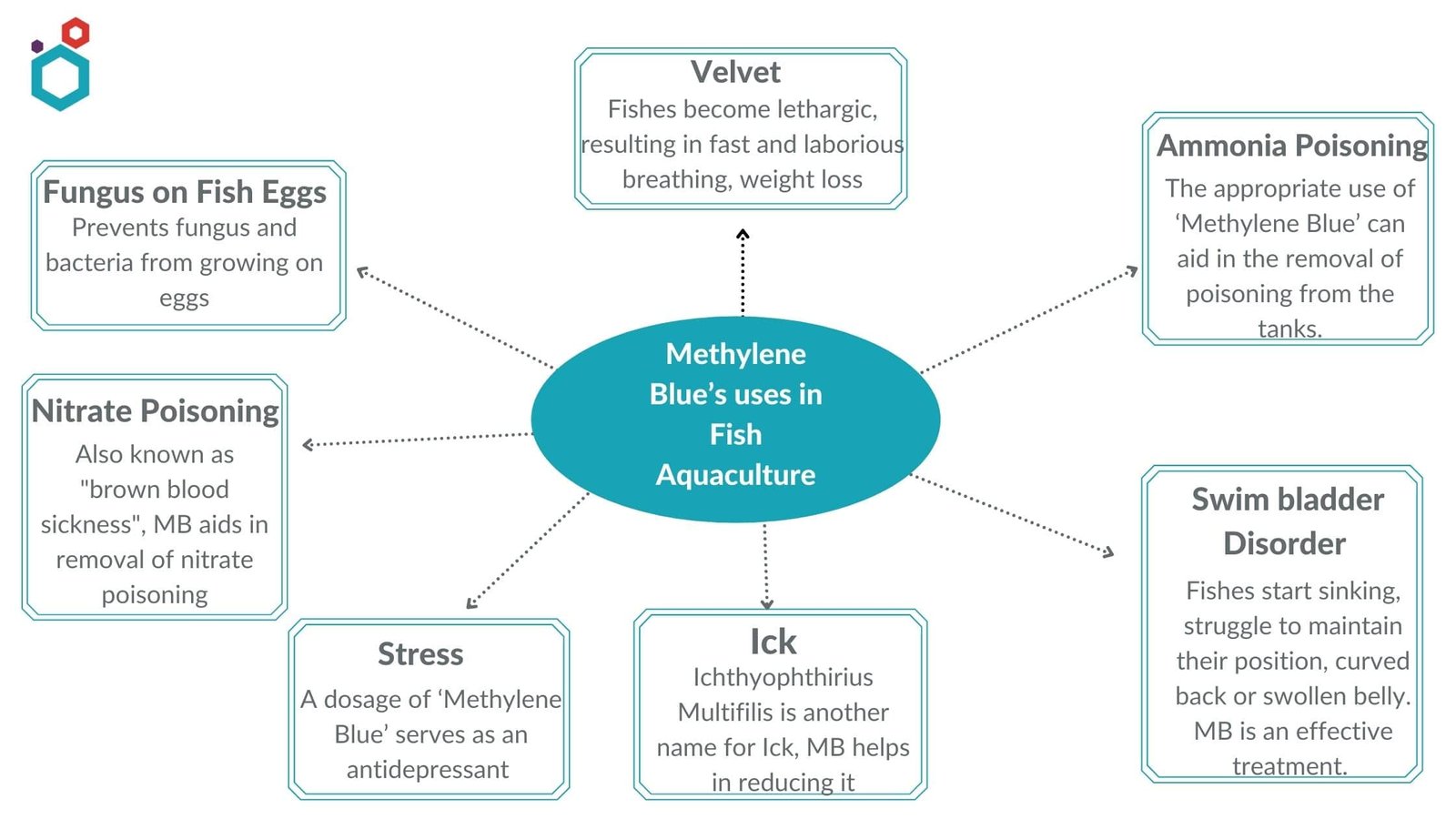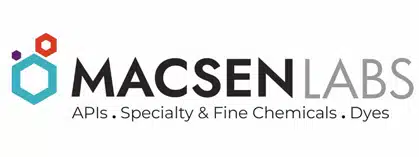Home » Blog » Methylene Blue » Methylene Blue for Fish Aquaculture | Uses and Precautions

Methylene Blue is utilized in aquaculture as an antifungal and anti-parasitic, and it is widely used to treat fish eggs to prevent fungal overgrowth. It is effective in killing protozoa and other aquatic parasites in fish. Methylene Blue is a safe aquarium disinfectant that is also used to treat toxicity often caused by ammonia and nitrite. This compound is highly safe to use and does not damage or kill the fish, provided it is used in limited dosage and one does not overdose the fish with it.
Table of Contents
When to use methylene blue for fish
Methylene Blue is beneficial against superficial fungal infections in fish. When it is known that the fish to be treated are sensitive, this medication is used instead of Malachite Green to suppress fungus. MB can be used to prevent fungal diseases in fish eggs and fry. It is also effective against several external protozoans, including Costia, Chilodonella, and Ichthyophthirius (Ich)
Methylene Blue is also effective in killing skin and gill flukes, ick, velvet, fungus, and many bacterial diseases and external parasites. Even for many invertebrates, this chemical is quite safe to use. MB acts by colouring cells and preventing them from metabolising.
Methylene Blue is safe to use with crustaceans such as crabs, shrimp, and snails, but it must be introduced slowly. It will harm living plants and should be handled cautiously in such situations, ensuring that plants are only exposed for short periods of time.
Uses for Fish Aquaculture
Fungus on Fish Eggs
Methylene Blue’s most common application in aquaculture is to prevent fungus and bacteria from growing on eggs. Fungal overgrowth and dangerous bacteria around eggs might cause the eggs to be lost in the aquarium, potentially harming the eggs.
In this case, Methylene Blue acts as a disinfectant to protect newly deposited fish eggs. It can also aid individuals who desire to hatch the fish eggs sooner artificially.
Nitrate Poisoning
Also known as ‘brown blood sickness.’ In this scenario, the methemoglobin levels rise, leading to an increase in nitrate toxicity. While various aquatic organisms have varying levels of nitrate tolerance, when the threshold of tolerance is exceeded, the fish get ill and diseased as a result of the poisoning.
Infected fishes become listless, hang near water exits, and begin grasping at water surfaces for oxygen, fast movement of gills known as ‘killing,’ and changes in gill colour from tan to brown gills. The proper use of ‘Methylene Blue’ can aid in the removal of poisoning from the tanks.
Ammonia Poisoning
It is caused by an increase in the pH of the tank and has an impact on the nitrogen cycle. This poisoning can be caused by decomposing organic waste or tap water in the tank, but the absence of ammonia levels shows that the water conditions are excellent. A modest degree of ammonia poisoning can be deadly by destroying fish gills, but large quantities can be much more hazardous to the fish’s survival.
Infected fish begin gasping for air, are sluggish or lethargic, their gills became purple or red, they develop crimson streaks on their bodies and fins, and they might die at the bottom of the tank. The appropriate use of ‘Methylene Blue’ can aid in the removal of poisoning from the tanks.
Velvet
It’s also known as ‘Oodinium, Rust, or Gold Dust Disease.’ This is the most prevalent illness in aquarium or tank fish. The parasites Oodinium limnetic and Oodinium Pilularis, which affects both saltwater and freshwater fish, are the cause of it. Fish scrape against hard surfaces to escape the velvet, but when assaulted, they become lethargic, resulting in fast and laborious breathing, weight loss, clamping of fins against the body, lack of appetite, rusty or yellow-coloured velvety coating on the skin, and in severe cases, the skin peels off. In this case, even a small amount of ‘Methylene Blue’ can act as an antiparasitic.
Stress
Fish frequently experience stress as a result of a variety of causes, particularly when they are transferred or when the conditions in their tanks change. Prophylactic therapy is utilised to alleviate tension in this circumstance. A dosage of ‘Methylene Blue’ serves as an antidepressant in this circumstance.
Ick
Ichthyophthirius Multifilis is another name for Ick. This illness is analogous to a skin infection. Infected fish began clawing against gravel and pebbles and may grow sluggish as they progressed. This type of infection creates tiny white patches on their skin that resemble sand, as well as crimson streaks or redness in increasing infection circumstances.
The use of ‘Methylene Blue’ can progressively reduce the parasite protozoa Ichthyophthirius multifiliis, however, the combination of formaldehyde and malachite green can be more successful.
Swim bladder Disorder
It is caused when the swim bladder doesn’t function properly. Its functionality can be affected due to mechanical or environmental factors such as any disease or physical defect. Infected fishes show a variety of symptoms such as they start sinking at the bottom of the aquarium, struggling to maintain their position and standing on their head, floating upside down, and often facing problems with buoyancy. They get a curved back or swollen belly so their physical appearance is also affected in certain ways. Methylene Blue is effective in treating this condition too.
How to use Methylene Blue for Fish
- When your fish’s lives are in danger, selecting the correct medicine is a vital and tough decision. Consider compiling a thorough inventory of all of your aquarium’s residents before seeking any type of therapy.
- Follow the recommendations on the product package or the advice of your local fish expert before adding methylene blue to your tank.
- For direct aquarium application, 1 drop of liquid methylene blue or 1 teaspoon of powdered mixture per 10 gallons of water is the typical guideline. To make marine dip solutions for saltwater fish, combine 1 teaspoon of the medicine with 5 litres of water. Don’t add methylene blue powder directly to the tank, rather, dissolve it in a small amount of water and then mix it in the tank.
- Add 1 teaspoon of 2.303 per cent Methylene Blue per 10 gallons of water to prevent or cure fungus on fish eggs. This results in a 3 ppm concentration. For higher concentrations, add roughly 1/3 teaspoon (1.64 ml) per 10 gallons for each 1 ppm increase necessary.
- There is only one application required. Treatment should be continued for 3 days following the free-swimming stage or 2 days after delivery for livebearers.
- Methylene Blue can also be used as a dip to treat fish with fungal diseases, those infected with external protozoan parasites, or those suffering from cyanide poisoning.
- Prepare a nonmetallic container large enough to hold the fish to be treated by filling it with water from the original tank.
- For every 3 litres of water, add 5 teaspoons (24.65 mL). This results in a 50 ppm concentration. It is not suggested to increase the concentration above 50 ppm.
- Immerse the fish to be treated in this solution for no more than 10 seconds.
- Reintroduce the fish to their original tank.
Precautions while using Methylene Blue for Fish
- Methylene Blue is a potent phytotoxin, which means it targets all sorts of bacteria and microorganisms, even beneficial ones. This is one of the main reasons why dosing the aquarium instead of a quarantine tank is dangerous. Before doing bath or dip treatments, move your fish to a temporary holding tank.
- In certain situations, treating the main tank is the only option to solve the issue. If you use MB, you will have to treat your primary tank directly to cure chemical toxicity or battle external parasites. In this scenario, removing the live carbon filter to protect the bacteria within is crucial and you can replace it later. During the treatment procedure, install a temporary mechanical filter for ease.
- Methylene Blue should not be used with Erythromycin or Tetracycline at the same time.
- After using methylene blue, keep a watchful eye on your tank, just like you would with any other therapy. After three to five days, replenish roughly a quarter of the water in your aquarium and the carbon filter.
FAQs
Is methylene blue safe for fish/ can methylene blue kill fish?
Methylene blue USP is highly safe to use and does not damage or kill the fish, provided it is used in limited dosage and one does not overdose the fish with it.
Is methylene blue safe for plants?
Unless you use a large dosage of methylene blue, it should not damage your plants. You should be okay as long as you follow the dosage instructions. It will harm living plants and should be handled cautiously in such situations, ensuring that plants are only exposed for short periods of time.
Can methylene blue kill fish lice?
Methylene blue is effective against parasites so it can help to get rid of fish lice.
Does methylene blue kill parasites in fish?
Methylene Blue can help kill protozoa and other aquatic parasites in fish.
Does methylene blue cure fin rot?
Using Methylene blue for fish can cure fin rot due to its antifungal and anti-parasitic properties. Methylene blue is also used to protect fish eggs from fungal overgrowth. Before using the product please confirm that the product you are using is for freshwater or saltwater.
Other articles on Methylene Blue:-
- Methylene Blue Dye | Chemistry, Uses & Side effects
- Methylene blue for treating methemoglobinemia
- Staining with Methylene Blue
- Methylene Blue & Covid 19, Research so far
- Methylene Blue in the treatment of Alzheimer’s
- Methylene Blue Against Cyanide Poisoning
- Methylene Blue Injection: Indications, Dosage & Brands
- Malaria Treatment with Methylene Blue
- Methylene Blue treatment for Lumpy Skin disease in cattle
- Methylene Blue for Cancer Therapy
Disclaimer-
The information provided here is based on general knowledge, articles, research publications etc and we do not claim the authenticity of any of the information provided above. We do not claim or suggest/advise any medical, therapeutic, health or nutritional benefits of MB. We do not supply or promote our MB product for the applications which are covered by valid patents and which are not approved by the FDA.
Macsen Labs is a manufacturer and supplier of several grades of Methylene Blue such as:-
- Methylene Blue USP
- Methylene Blue Zinc Free
- Methylene Blue BP 2000
- Methylene Blue BP 1973
- Methylthioninium Chloride BP
- Methylthioninium Chloride EP 9.0
- Methylthioninium Chloride E.P-10
Macsen Labs group’s Methylene Blue Synthesis Process granted a patent from the Indian patent office
The Indian Patent Office granted a patent to Mr Achal Agrawal, CEO of Macsen Labs, Udaipur. The title of the patent is Novel Improved Method for Synthesis of Diaminophenothiazine Compounds and it concerns a novel process for synthesising the compound Methylthioninium Chloride or Methylene Blue. Macsen Labs has now achieved a unique position by this patent and from now nobody will be able to copy this process. Read more



